At Charing Cross Station the impressive building facing the road provided by the South Eastern & Chatham Railway (SE&CR) has been retained and still has its hotel (now called the AMBA HOTEL CHARING CROSS). The original, fairly modest, concourse enjoying good natural lighting also remains but redevelopment has made the platforms themselves subterranean in appearance, illuminated by elaborate but rather dated looking lighting.
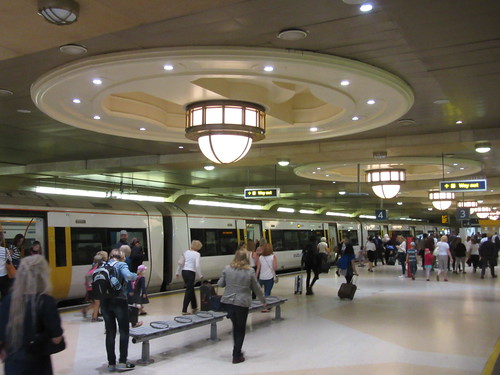 Platforms 3 and 4 at Charing Cross.
Platforms 3 and 4 at Charing Cross.
I realised that Southeastern trains do not currently stop at London Bridge, which is currently the focus of major works under the title Thameslink Programme, so I boarded the first departure and travelled just one stop to Waterloo East to see what's there now.
Immediately before arriving at Waterloo East, there's a good view of Waterloo terminal station next door. The elegant facade of the station contrasts oddly with the extended graffiti on the viaduct carrying the Charing Cross route.
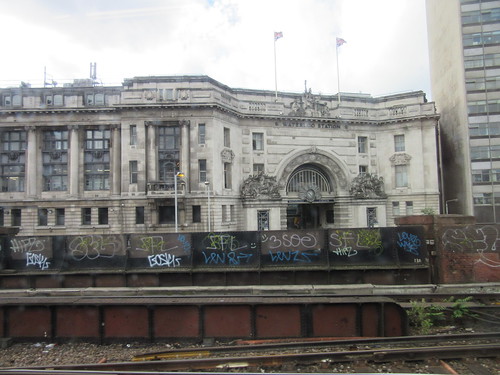 Waterloo station: The elegant facade of the station contrasts oddly with the extended graffiti on the viaduct carrying the Charing Cross route.
Waterloo station: The elegant facade of the station contrasts oddly with the extended graffiti on the viaduct carrying the Charing Cross route.
Waterloo East is a quite attractive station on the quadruple track route (paired by use) from Charing Cross to London Bridge. There is one island platform and two flanking platforms, all identified alphabetically as A - D, presumably to avoid confusion with its rather larger sister, Waterloo, to which it is connected by a footbridge at the Charing Cross end of the platforms. The early platform awnings and buildings survive, in a good state of restoration. I found the multi-coloured brickwork, simple detailing and cast iron, decorated columns quite pleasing.
Of course, many of the modern features jar. At some stage, the footbridge has been enclosed with the top pierced by a series of rather mean-sized windows. To accommodate all the electrical, signalling and communication requirements of today's railway, the buildings have been adorned with surface-mounted cable trunking. At the London Bridge end of the station, a subway interconnects the platforms and gives access to Southwark Underground station on the Jubilee Line. Needless to say, the interconnection to the Jubilee Line is in 'modernist' style, indifferent to the earlier station features with which it is juxtaposed. Modern platform awnings have been provided to cover what was formerly the exposed ends of the platforms - a useful feature but materials, treatment and even the roof height differ from the original.
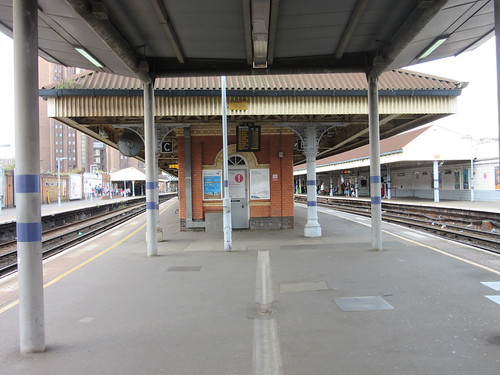 Waterloo East station: looking towards Charing Cross.
Waterloo East station: looking towards Charing Cross.
I took the footbridge to Waterloo main station where the pedestrian route emerges at the Waterloo Balcony Level. Escalators connect the Balcony with the concourse level and the platforms. I've written a little about the terminus at Waterloo in the post Waterloo Station, London. I took the opportunity to take a picture of the famous 4-sided clock.
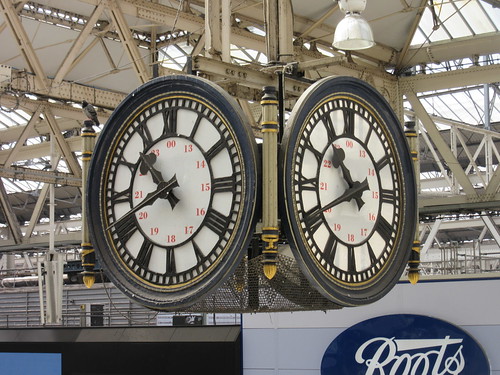 Waterloo station: Detail of the famous clock suspended above the concourse.
Waterloo station: Detail of the famous clock suspended above the concourse.
The short-lived and expensive platforms of Waterloo International (which were used by 'Eurostar' trains before HS1 and St. Pancras International were opened) have been brought into use again for domestic services, but I hadn't time to check out this area, instead descending the escalator to Waterloo underground station and catching a Jubilee Line service to London Bridge.
I walked to my meeting at a building near the moored H.M.S. Belfast, which I visited in 2012 as described here. With business concluded, I returned to London Bridge station. In order to have a closer look at the rebuilding in progress, I decided to catch a train from London Bridge to Cannon Street.
Until the Thameslink Programme started, London Bridge had six through platforms serving the SE&CR lines from the termini at Charing Cross and Cannon Street. The remainder of the platforms used by the Lodon Brighton & South Coast Railway (LB&SCR) were terminal, covered by an airy, glazed all-over roof comprising a central arched roof flanked by a series of glazed bays on either side.
 London Bridge in 2010 showing the terminal platforms with their all-over roof. The egregious 'Shard' starts its inexorable rise in the background.
London Bridge in 2010 showing the terminal platforms with their all-over roof. The egregious 'Shard' starts its inexorable rise in the background.
All this has changed. On my visit, there were three through platforms serving the Cannon Street lines. The other through platforms have gone, replaced by two temporary through lines allowing Charing Cross services to run through without stopping. Six terminal platforms remain in use, connected to a large, new concourse area abutting the base of the Shard (the European Union's tallest building according to the Wikipedia article here. Later, at the beginning of 2017, I made a visit to 'The View from the Shard', described here, which gives excellent views of the railways around London Bridge).
It was only after my visit that I found the Network Rail description of the London Bridge project here and a Station Guide showing what's currently in use here.
 London Bridge in August 2015. View from platform 2 showing the grey hoarding dividing off the worksite, where two men can be seen working on new platform roofing. Red construction crane on the right and the base of the Shard.
London Bridge in August 2015. View from platform 2 showing the grey hoarding dividing off the worksite, where two men can be seen working on new platform roofing. Red construction crane on the right and the base of the Shard.
I boarded a Cannon Street service but we'd only moved a short distance before suffering a signal check. Then, we slowly crossed the River Thames and arrived at Cannon Street station. The station retains its elegant twin towers but they are made to look faintly ridiculous by the appearance of the commercial development which has replaced the all-over roof, condemning yet another set of station platforms to a twilight existence.
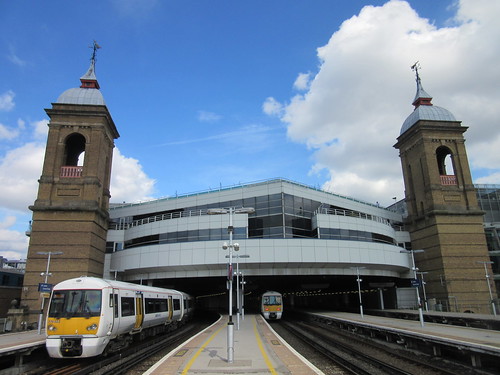 London Cannon Street Station.
London Cannon Street Station.
I descended to the Underground at Cannon Street - this time to the District and Circle Line forming part of the 'Sub-Surface Line' network built using cut-and-cover techniques. The westbound train I caught was one of the fairly new 'S stock' sets built by Bombardier. They have similarities with the Bombardier sets for the London Overground featuring wide, walk-through access from coach to coach. I think they appear in seven- and eight-coach variants, with different seating plans. The set I travelled in had seating set against the sides allowing more space for standing passengers.
 District & Circle Line: Bombardier 'S' stock.
District & Circle Line: Bombardier 'S' stock.
I changed trains at Embankment, catching a Northern Line train back to Euston where I boarded a Virgin service to Birmingham. Another train and a bus concluded my travelling for the day.
My pictures
London Charing Cross Station.
London: Waterloo Station.
London Bridge Station.
London Cannon Street Station.
[Link to post about visiting the Shard added 10-Apr-2017]
